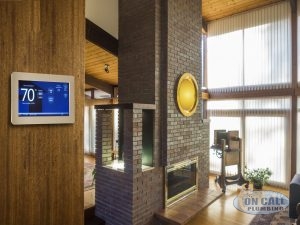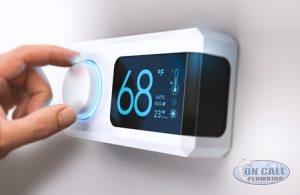
A Digital Thermostat Offers Modern Style and Simplified Adjustment. Which Model Works for You?
How many times have you heard about getting a new digital thermostat, when you ask your HVAC professional how to save money on heating and cooling? There’s a reason why you hear about them so often. It’s not a catch all solution for dealing with all your HVAC problems, but there’s great opportunity to save big on your wintertime energy costs!
Today, we’ll be talking about thermostat functionality, breaking down bad thermostats, and explaining how to manage your own home thermostat. By the end, you should have a stronger understanding of your thermostat’s energy usage, and know what to look for in a new model. Let’s get started!
How Does a Thermostat Work?
Picture a switch in your mind. As the temperature rises or falls to a certain degree, the switch flips on, activating either the air conditioning or heating system. Once sensor detects the room has reached the desired temperature, the switch flips off.
There are many brands, models, etc. that offer additional perks, but that is the basic function of a electronic thermostat. Now, that function can be interrupted by all sorts of hazards. Some can be corrected with minimal effort, while others are fatal for your home thermostat.
What are the Symptoms of a Bad Thermostat?
The most obvious sign of a malfunction is an HVAC system that won’t activate. Your thermostat’s wiring may be disconnected from the heating and cooling hardware. The temperature sensor may also be taking false readings, which can cause your your air conditioning to run non-stop or not at all. Constant cooling will quickly run up your utility bill, while the alternative will leave your home uncomfortably warm.
How Do I Test My Home Thermostat?
Start by making sure it’s actually responsive to input. Adjust the desired temperature until air conditioning kicks in. If the unit is unresponsive, don’t worry! The problem may just be degraded batteries. Try replacing them and seeing if your thermostat responds. If you still don’t have any response, it’s time to call your HVAC company.
What to Look For During Thermostat Inspection
- Uneven heating and cooling throughout the house
- Short cycling (frequently turning on and off)
- No reaction to temperature changes
- Power loss in the thermostat
- Constantly running air conditioning or heater
Selecting a New Home Thermostat
Below are the standard choices available for homeowners these days. There’s a wide variation in price based on features and installation costs. There’s also a vast difference in energy efficiency.
Manual
Manual Thermostats
If you prefer pushing buttons to adjust your home temperature, a manual thermostat may be the simple choice. They’re remarkably cheap and easy to use. No nonsense! If you want to save on energy however, you’ll have to be faithful to adjust the controls when you leave home, return, and go to sleep.
Programmable
Programmable Thermostats
What should you set your thermostat at in the winter? 68 degrees when you’re home. However, that may be a question you don’t even have to bother asking anymore. With manual thermostats, you have to consistently return to the wall to change the temperature. That’s a small task that has big consequences on your energy costs, but many homeowners forget to change the temperature to save money.
With programmable thermostats, you can schedule preferred temperatures at specific times. Going to be away from the house for most of the afternoon each Thursday? Program the home thermostat to lower the system usage during that time. Want to have your thermostat turn off the Trane heater while everyone sleeps? That’s also easy to do.
Of course, you also maintain the basic push and adjust capability.
Smart
Smart Thermostats
Smart models take programmable features and take them to the next level: learning and automatic adjustments. Nest Thermostats popularized this type of temperature control, and it continues to be a big player in the residential market. There are other suitable brands available too.
Smart thermostats analyze your usage patterns and automatically adjust the temperature to your preferred settings. They can also make changes based on your away time during the day, to maximize energy savings. Certain manufacturers also provide Wifi enabled systems, such as smart phone compatibility that allows you to change your home’s temperature while you’re away.
If you’re looking for a new thermostat with minimal interaction requirements, smart models are definitely worth consideration.
One Last Note

Programmable and Smart Thermostats Still Include Manual Adjustment For Simple Temperature Changes.
While programmable and smart thermostats certainly offer energy savings, usage habits still matter. Of course, that’s true for your high-efficiency washer/dryer, a brand new AC unit, or even your tankless water heater installation in Santa Clarita. Conscientious, planned usage of your new thermostat will ensure that you get the most value out of your investment.
Schedule Your Plumbing Inspection Today!
Is your home overdue for a professional plumbing inspection? Our team at On Call Plumbing would love to examine your home and provide general maintenance to extend the life of your water appliances! Give us a call today at 661-201-6016. We provide service for Santa Clarita, CA and other nearby communities.

